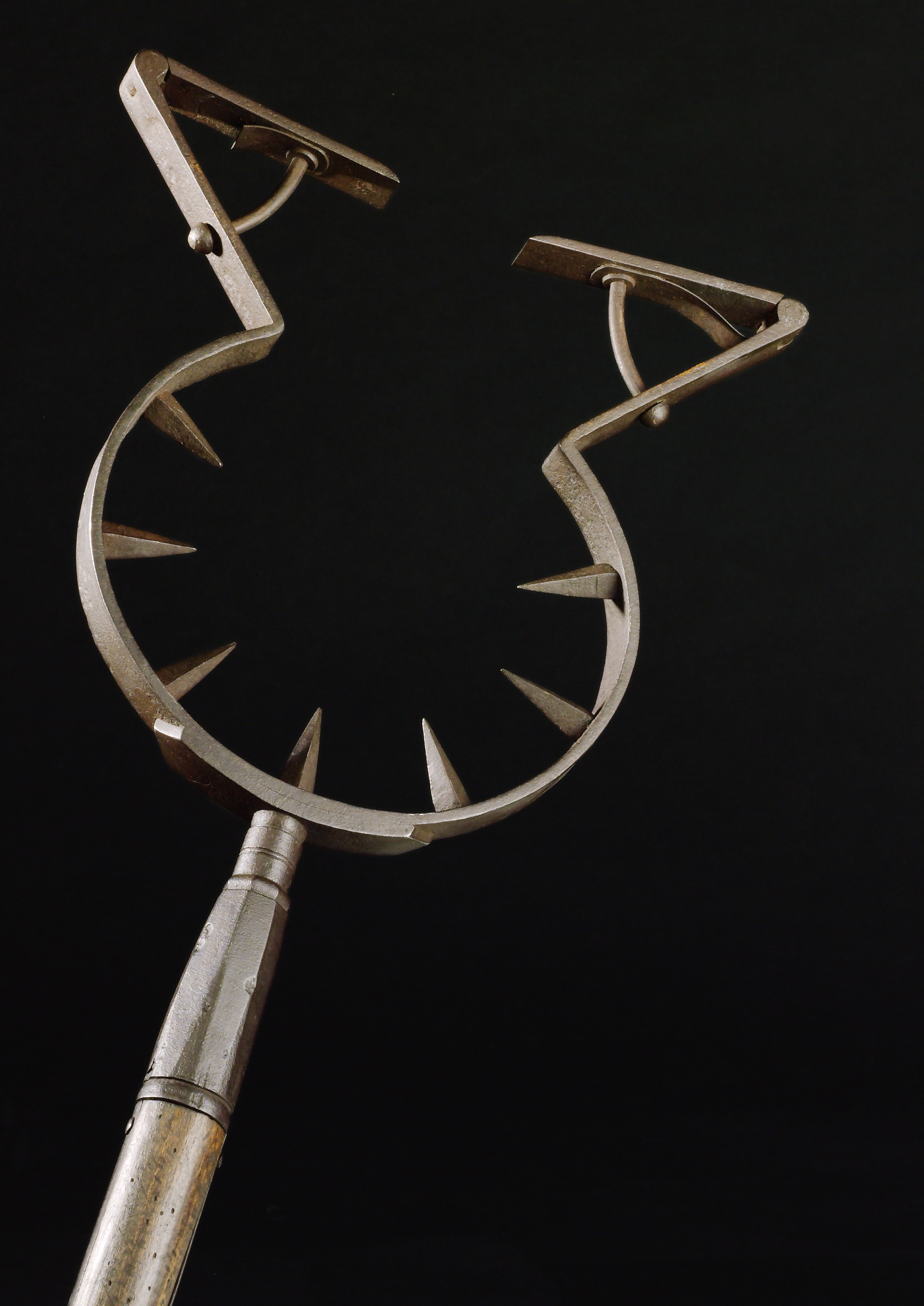Man Catcher on:
[Wikipedia]
[Google]
[Amazon]
 A man catcher, also known as catchpole, is an esoteric type of
A man catcher, also known as catchpole, is an esoteric type of
 A man catcher, also known as catchpole, is an esoteric type of
A man catcher, also known as catchpole, is an esoteric type of pole weapon
A polearm or pole weapon is a close combat weapon in which the main fighting part of the weapon is fitted to the end of a long shaft, typically of wood, thereby extending the user's effective range and striking power. Polearms are predominantly ...
which was used in Europe as late as the 18th century. It consisted of a pole mounted with a two pronged head. Each prong was semi-circular in shape with a spring-loaded "door" on the front. This created an effective valve that would allow the ring to pass around a man-sized cylinder and keep it trapped. The man catcher was used primarily to pull a person from horseback and drag him to the ground where he could be helplessly pinned. This is one of the few examples of less-lethal polearms
A polearm or pole weapon is a close combat weapon in which the main fighting part of the weapon is fitted to the end of a long shaft, typically of wood, thereby extending the user's effective range and striking power. Polearms are predominantly ...
.
The design assumes that the captured person wears armor to protect him against the metal prongs, which could easily hurt the neck of a person without armor. The man catcher was also used to trap and contain violent prisoners.
Similarly, the Japanese '' sodegarami'', '' tsukubō'', and ''sasumata
The is a pole weapon used by the samurai class and their retainers in feudal Japan.
Description and use
Although some sources place the origin of the sasumata in the Muromachi period, most sources discuss its use in the Edo period. In Edo peri ...
'' were used by Edo-era law enforcement for apprehending suspects. However, the ''sasumata'' was most like a man catcher in usage as its forked head was designed to pin the suspect's neck, legs, arms, or joints against a wall or the ground.
Modern variants
Japan
While other man catchers are no longer in use, the ''sasumata
The is a pole weapon used by the samurai class and their retainers in feudal Japan.
Description and use
Although some sources place the origin of the sasumata in the Muromachi period, most sources discuss its use in the Edo period. In Edo peri ...
'' (described above) currently has modern variants that are semi-flexible, with padding, blunt endpoints, and other slightly modified geometry, designed to significantly reduce the chance of injury to restrained civilians. These variants are designed for use by non-soldiers—specifically, they are intended for use by a Japanese riot police
Riot police are police who are organized, deployed, trained or equipped to confront crowds, protests or riots.
Riot police may be regular police who act in the role of riot police in particular situations or they may be separate units organi ...
mounted on horseback. In such a case, the mounted riot police would typically be arranged in formation line abreast, and would use a row of raised ''sasumata'' to hold back large crowds. These mounted riot police answer to the Japanese National Police Agency National Police may refer to the national police forces of several countries:
*Afghanistan: Afghan National Police
*Haiti: Haitian National Police
*Colombia: National Police of Colombia
*Cuba: Cuban National Police
*East Timor: National Police of ...
. Since the outbreak of serious riots is uncommon in Japan, the modern ''sasumata'' is rarely used. Nevertheless, the necessary training is kept up to date.
China
A type of locking man catcher is available for staff at train stations and airports in China to capture and restrain individuals in a non-lethal manner. In some junior and middle schools, security guards are equipped with non-locking variants designed to seize a person's waist or prevent them from advancing. It is essentially a two-pronged fork, a ''U''-shape projecting from a pole.India and Nepal
During theCOVID-19 pandemic in India
The COVID-19 pandemic in India is a part of the worldwide pandemic of coronavirus disease 2019 () caused by severe acute respiratory syndrome coronavirus 2 (). As of , according to Indian government figures, India has the second-highest n ...
, police in Chandigarh implemented a mechanical device resembling a man catcher in order to capture suspects while maintaining a safe social distance. It was created to be used on a person's waistline. They called it a "social distancing clamp" or a "lockdown-breaker catcher". It was based on an idea from police in Nepal, where officers have reportedly detained over 1,400 suspects using a similar "multifunctional arrest device". Mancatchers were also used for other purposes such as pulling dead bodies out of the water. The main difference between the designs is that those used in India expand the size of the clamp depending on the person's waistline.
See also
*Monk's spade
A monk's spade (; also, ), also called a Shaolin Spade, is a Chinese pole weapon consisting of a long pole with a flat spade-like blade on one end and a smaller crescent shaped blade on the other. Neither blade was designed to be sharpened. In ol ...
, one end has similar function but for animals
*Sasumata
The is a pole weapon used by the samurai class and their retainers in feudal Japan.
Description and use
Although some sources place the origin of the sasumata in the Muromachi period, most sources discuss its use in the Edo period. In Edo peri ...
- In Japan case
References
External links
* {{Commons category-inline, Man catchers Polearms